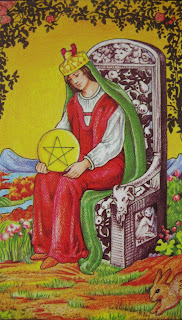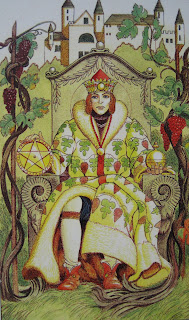Previous | Master List | Next
Welcome to Alison’s Alembic! You may have arrived here as a stop on the
Tarot Blog Hop from either Jay's Metaphysical Angels or Willow Path Tarot's blog. Or
you may have found this through TABI’s Facebook page, or though one of the many
wonderful tarot bloggers in the ether... It doesn’t matter – what does matter is that you’re here!
Imbolc (pronounced i-molk
or i-molg), also called Brigid’s
Day or Candlemas, is a cross-quarter festival , marking the end of winter and
beginning of spring (in the northern hemisphere). The name ‘Imbolc’ comes from
the old Irish “i mbolg”, meaning “in the belly”, referring to the time of year
when sheep and goats are pregnant, carrying their young. Other etymology includes “oimelc”, meaning
“ewe’s milk”, a reference to the onset of lactation in ewes about to give
birth.
Birth, beginnings… a time of hope, a time to look towards
the future, and what might be.
As the Celtic year was based on both lunar and solar cycles,
the festival would probably have been celebrated on the full moon nearest the
midpoint between the Winter Solstice (Yule) and the Vernal Equinox (Ostara) …
in the northern hemisphere, at least!
Our wrangler for this particular round of the Tarot Blog
Hop, Aisling, points out that this
year, this festival is in fact a ‘trifecta’, a combination of three significant
events on a single day. Imbolc itself, the Full Moon on the 31st
January, and the fact that it’s the second Full Moon of the month (the ‘Blue’
Moon). That means we’re celebrating a
“Solilune”, a combination of a Solar and Lunar festival. Brigid herself is
associated with the number three, through the elemental spaces of Land, Sea,
and Sky, as well as the three characteristics of the Inner Flame: poesy, smith-craft,
and healing. Aisling also reminds us of
the gift of Spirit represented by the Blue Moon – the rare and precious things
that occur ‘once in a blue moon’.
At once my mind goes to Nanci Griffith’s beautiful ‘Once in a Very Blue Moon’…
But back to tarot…
Aisling’s provided us with a spread, based on all this
three-ness. It comes in three parts, with each part involving three cards. I’m using the beautiful Wildwood Tarot.
1) The Foundation - honouring the solar festival of Imbolc and the Three Fires of Brigid.
The first of the three cards in this first of three sections represents Land and the body - the physical focus for the year ahead. I drew the Nine of Arrows. Subtitled 'Dedication', this reminds me that I need to be willing to work hard and be very disciplined when it comes to the physical side of life. This speaks to me on a personal level (wanting to regain my old level of physical fitness after a couple of years of battling health issues) but also in terms of being a 'protector of the Land', something else that has had to take a back seat for the past year or so. I see those eight arrows being repulsed by the invisible shield as all the things I've allowed to stand in my way, and that I now need the self-discipline to move past.
The second card represents Sky and the mind - the mental focus for the next 12 months. Here I have The Stag (8), indicating the need to take responsibility for my thoughts and beliefs, for any ideas I come up with. There's also a lot about strength and protection in here too, which will provide a good foundation for the second set of three cards (The Construction). It feels fitting to have this card here, given the astrological association of the Sun (rules Leo, the sign usually associated with Strength) - good solar energy! The creators of the Wildwood Tarot envisaged the Stag as a combination of Strength and Justice, drawing on qualities of both. Strength, personal integrity, working for justice...I can see this at work already in this year's goals.
The final card in this section represents Sea and spirit, the emotional and/or spiritual focus of the year to come. The Four of Vessels suggests I need to be aware of wasting my energy, and of allowing myself to remain feeling emotionally drained after illness. I need to get off my backside and take action! Step through those gateways when they appear, or risk boredom....
....and speaking of gateways....
2) The Construction - honouring the lunar energy of the year. With this being the Full Moon associated with the rowan tree, we're looking at protection and guidance, and at guardians and gateways.
The first card in this middle section symbolizes the new path that presents itself. Back to the Arrows again for the first card in this third; this time it's the Seven of Arrows. The Green Woman in the image fends off the barrage of arrows, protecting herself. Very apt, in terms of the Rowan Moon we're celebrating. But what about the new path that presents itself? This is about not allowing fears - especially ones that are all in my mind and not rooted in reality - and confusion to hold me back. I see this at work already - for example, I'm panicking about a workshop I've been asked to run, even though it's months away. This particular fear is an old and very familiar one - the clue comes in the card's subtitle: insecurity! Self-doubt and lack of confidence....
The second card shows me what I will need protection from on my journey this year. I have to admit I was initially very pleased to see The Hooded Man (9) appear here - one of my favourite cards from this deck. But when I thought about the position it's in, I'm less sure! I like to give myself time and space to prepare for things, withdrawing when needed so that I can be still, and absorb what's going on so that I can better understand before taking the next step. But here it might be saying that I need to be wary of withdrawing too much - that doing so might not be in my best interests. Hmm.
The third card indicates what will guide and protect me. Two cards came out together here - the Three of Vessels and the Ten of Bows. 'Taking joy in responsibility' is what immediately comes to mind, based on the subtitles of each card. That reinforces the messages of the previous cards, I'd say - taking pleasure in what I've been asked to do or want to initiate, rather than resorting to the default position of panic and uncertainty - and, thinking about The Hooded Man's message, not to withdraw too quickly from added responsibility. Now I wonder if there's two sides to The Hooded Man's appearance here: it will be OK to take the time to work out how much responsibility I can realistically take on, and learn to say 'no' when I reach my limit.
3) The Surprise - what 'once in a blue moon' treasures does the Universe have in store?
The first card in this third and final section takes us back to the realm of the Land and the body - the physical. I've drawn The Shaman (1). This will help me understand what it is I can contribute to the world. Again, I see a link to the Hooded Man - taking time out to meditate, to listen to my inner guides, in order to gain insight. It also reminds me that I have all the tools I need already - it's up to me to work the magic.
The next card looks at surprises in terms of the Sky - the mind. The only card from the earthy suit of Stones appearing here, the Ace of Stones suggests the seed of a new idea - something I can nurture into maturity over the course of the year. Great surprise - can't wait! The combination of Earth and Air feels promising...perhaps that long-sought-after new source of income will manifest this year!
1) The Foundation - honouring the solar festival of Imbolc and the Three Fires of Brigid.
 |
Nine of Arrows (trimmed):
© Wildwood Tarot
|
 |
8 The Stag (trimmed):
© Wildwood Tarot
|
 |
Four of Vessels (trimmed):
© Wildwood Tarot
|
....and speaking of gateways....
2) The Construction - honouring the lunar energy of the year. With this being the Full Moon associated with the rowan tree, we're looking at protection and guidance, and at guardians and gateways.
 |
Seven of Arrows (trimmed):
© Wildwood Tarot
|
 |
9 The Hooded Man (trimmed):
© Wildwood Tarot
|
The third card indicates what will guide and protect me. Two cards came out together here - the Three of Vessels and the Ten of Bows. 'Taking joy in responsibility' is what immediately comes to mind, based on the subtitles of each card. That reinforces the messages of the previous cards, I'd say - taking pleasure in what I've been asked to do or want to initiate, rather than resorting to the default position of panic and uncertainty - and, thinking about The Hooded Man's message, not to withdraw too quickly from added responsibility. Now I wonder if there's two sides to The Hooded Man's appearance here: it will be OK to take the time to work out how much responsibility I can realistically take on, and learn to say 'no' when I reach my limit.
 |
Three of Vessels (trimmed):
© Wildwood Tarot
|
 |
Ten of Bows (trimmed):
© Wildwood Tarot
|
3) The Surprise - what 'once in a blue moon' treasures does the Universe have in store?
 |
1 The Shaman (trimmed):
© Wildwood Tarot
|
The first card in this third and final section takes us back to the realm of the Land and the body - the physical. I've drawn The Shaman (1). This will help me understand what it is I can contribute to the world. Again, I see a link to the Hooded Man - taking time out to meditate, to listen to my inner guides, in order to gain insight. It also reminds me that I have all the tools I need already - it's up to me to work the magic.
 |
Ace of Stones (trimmed):
© Wildwood Tarot
|
 |
Six of Vessels (trimmed):
© Wildwood Tarot
|
A card from the suit of Vessels and from the Majors in each of the three sections of the reading: an important year to stay in touch with my feelings, perhaps?! Not forgetting two cards from the Arrows - 'head' and 'heart' both important.
So, thank you, Aisling, for setting us this ‘illuminating’ topic,
drawing on the energies of both luminaries as it does. I’ll leave you with a photo of a dear friend
of mine - named Soliluna!
And thank you all for stopping off here on your own journey
through this Imbolc Tarot Blog Hop.
Please do come back and read some of my other posts through the year.
The next stops on the Tarot Blog Hop are - depending on
whether you’re moving backwards or forwards through the list – Jay's Metaphysical Angels and Willow Path Tarot. The Master List can be found here.
Previous | Master List | Next
Wildwood Tarot created by Mark Ryan and John Matthews, illustrated by Will
Worthington, published by Connections


























